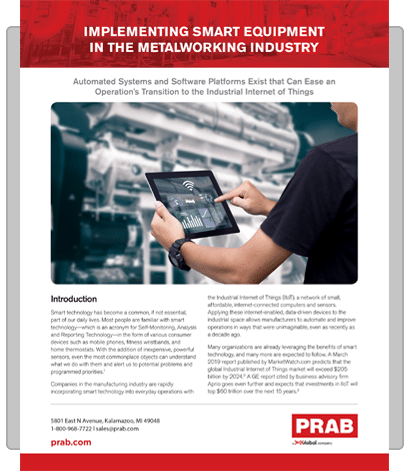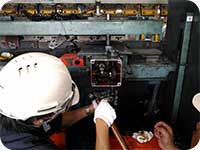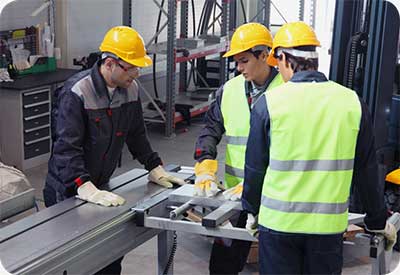

Smart technology has become a common, if not essential, part of our daily lives. Most people are familiar with smart technology—which is an acronym for Self-Monitoring, Analysis and Reporting Technology—in the form of various consumer devices such as mobile phones, fitness wristbands, and home thermostats. With the addition of inexpensive, powerful sensors, even the most commonplace objects can understand what we do with them and alert us to potential problems and programmed priorities.1
Companies in the manufacturing industry are rapidly incorporating smart technology into everyday operations with the Industrial Internet of Things (IIoT), a network of small, affordable, internet-connected computers and sensors. Applying these internet-enabled, data-driven devices to the industrial space allows manufacturers to automate and improve operations in ways that were unimaginable, even as recently as a decade ago.
Many organizations are already leveraging the benefits of smart technology, and many more are expected to follow. A March 2019 report published by MarketWatch.com predicts that the global Industrial Internet of Things market will exceed $205 billion by 2024.2 A GE report cited by business advisory firm Aprio goes even further and expects that investments in IIoT will top $60 trillion over the next 15 years.3
These numbers clearly show that smart equipment and IIoT are already being incorporated into modern manufacturing operations to improve efficiency and increase profitability. However, there can be obstacles involved with effectively implementing a comprehensive IIoT program in a metalworking plant. In this white paper, we will examine those obstacles and discuss how they can be overcome by partnering with equipment and technology providers that have positioned themselves to accommodate the increasing presence of IIoT.
Technology media site and market intelligence platform ReadWrite reports that manufacturing industries all over the globe are the leading investors in IIoT. They are using industrial sensors, beacons, advanced RFID tags, connected equipment and more to collect and analyze data from various data points to optimize a myriad of manufacturing processes and operations.
Citing a white paper by leading business support solutions provider CSG, ReadWrite claims that of all the businesses that have chosen to implement IIoT within their systems, 94 percent have already seen a healthy return on their investments. Still, fewer than a third of industrial decision-makers have an articulated IIoT strategy in place for their businesses, and fewer than a quarter have a comprehensive plan for making use of it in the future.4
A 2018 manufacturing report from professional services firm Sikich found that fewer than 10 percent of those surveyed currently use IIoT technologies. Further, 30 percent said they have no clear understanding of the Internet of Things.5




A better understanding of IIoT is the key to addressing these factors and moving an operation toward the future. This is especially important for metalworking plants, because at an estimated value of $3.9 trillion, manufacturing is widely recognized as the industry with the most to gain from IIoT, according to digital transformation solutions provider Relayr.7
Fortunately, there are equipment and software experts that are already delivering IIoT solutions to the industry. They can help metalworking operations understand the technology and avoid the biggest detriment to efficiency and profitability: downtime of equipment and systems.
The very basis of IIoT involves a shift from preventive maintenance to predictive maintenance. Relayr compiled a list of the issues associated with preventive maintenance, which relies heavily on compiling previous statistics and making a best guess at how to prevent problems. In most cases, preventive maintenance is:
As this list indicates, the ineffectiveness of preventive maintenance—which can result in reduced equipment life, increased downtime, lost productivity and reduced revenue—should no longer be acceptable when a viable alternative exists. Predictive maintenance with IIoT uses the real-time, current condition of equipment and systems to determine when service is required. The days of studying old data and guessing about service intervals are essentially over because of predictive maintenance, which is:
All equipment and systems within a metalworking plant can benefit from IIoT, from front line production equipment to back-end systems that process scrap metal and spent fluid. Prioritizing the latter systems to maximize efficiency, profit margins and overall business value requires a reversal of conventional thinking that is also important to the adoption of IIoT capability throughout the plant in order to avoid downtime.
As for workforce concerns, they already exist in the metalworking industry regardless of the presence of IIoT technology. Manufacturing operations aren’t struggling to find work these days, thanks to a strong economy and a healthy construction market. Unfortunately, the dwindling number of highly skilled workers with deep industry knowledge poses a more serious challenge to ensuring that productivity keeps pace with demand.
Automating as many plant systems as possible—including scrap handling, fluid recycling and industrial water and wastewater systems—can not only address the staffing issue but offer other advantages that can directly benefit the bottom line. Implementing IIoT capability can achieve the same results, provided an operation fosters a culture that encourages “hand-in-metal” collaboration between humans and machines. Aprio recommends a two-part process:3
 It is vital that workers appreciate the benefits of IIoT and value the fact that this technology has the power to make a workplace more productive, engaging and satisfying. No longer burdened with moving materials from one point to another, floor operators will be able to devote their time and energy to other, more valuable tasks. Meanwhile, employees on the front line will be able to review data reporting on their inventory levels, production levels, scrap output and throughput to gain real-time insight into their productivity.
It is vital that workers appreciate the benefits of IIoT and value the fact that this technology has the power to make a workplace more productive, engaging and satisfying. No longer burdened with moving materials from one point to another, floor operators will be able to devote their time and energy to other, more valuable tasks. Meanwhile, employees on the front line will be able to review data reporting on their inventory levels, production levels, scrap output and throughput to gain real-time insight into their productivity.
 For those at the top of the organization, it is their duty to create a workplace environment in which the workforce feels empowered and encouraged to use real-time data to make decisions that will improve efficiency. Doing so will boost your bottom line and reduce the need for reactionary, top-down decision-making.
For those at the top of the organization, it is their duty to create a workplace environment in which the workforce feels empowered and encouraged to use real-time data to make decisions that will improve efficiency. Doing so will boost your bottom line and reduce the need for reactionary, top-down decision-making.
Regarding the software fears, there are platforms available today that are more than capable of enabling enterprises to integrate, connect and manage millions of IIoT components by operating connected business processes and consuming connected insights. When implemented on equipment and systems throughout a plant, these platforms allow metalworking companies to make changes or business decisions that affect positive operational changes, reduce risks, and increase revenue.
The software can operate across the cloud or on-premises and provides enterprises with total freedom and choice in designing, building, deploying and evolving their IIoT implementations seamlessly across any network. The ultimate objective is to help customers eliminate metalworking waste and improve the overall efficiency of their operations so they can increase their business profitability.8
As statistics indicate, the Industrial Internet of Things is quickly becoming a reality in the manufacturing industry, with IIoTrelated investments expected to be well into the billions within the next five years. However, many operations continue to lag behind when it comes to implementing and benefitting from IIoT. Reasons for this range from being wary of the technology’s reliability and effectiveness at this stage of its development to being satisfied with the way things have traditionally been done in metalworking plants.
Resistance to change should never be a barrier to innovation, especially when the advantages are tangible and solutions exist that can put most fears related to IIoT to rest. Working with a systems provider that is ahead of the curve and offers a proven, reliable software platform for its waste stream processing equipment can help a metalworking operation stay competitive by getting the maximum advantage and uptime from IIoT technology.

Mike Hook is the Sales & Marketing Director for PRAB and has more than 15 years of mechanical design and application experience. PRAB is a leading manufacturer of engineered conveyors and equipment for processing turnings, chips and metalworking fluids. PRAB also designs and builds industrial wastewater recycling systems.
1Netlingo, Smart Tech a.k.a. Smart Technology, Wearable Tech – https://www.netlingo.com/word/smart-tech.php
2MarketWatch, Industrial Internet of Things Market is Determined to Reach US$ 205.0 billion by 2024 – https://www.marketwatch.com/press-release/industrial-internet-of-things-market-is-determined-to-reach-us-2050-billion-by-2024-2019-03-08
3Aprio, How the Industrial Internet of Things Creates a “Hand-in-Metal” Workforce – https://www.aprio.com/whatsnext/industrial-internet-things-creates-hand-metal-workforce/
4ReadWrite, How IoT is Optimizing Costs for Industrial Sectors – https://readwrite.com/how-iot-is-optimizing-costs-for-industrial-sectors/
5Sikich, Many Manufacturers Slow to Adopt Internet of Things, Sikich Report Finds – https://www.sikich.com/many-manufacturers-slow-to-adopt-internet-of-things-sikich-report-finds/
6Serious Insights, The Slow Pace of IIoT Adoption –https://www.seriousinsights.net/why-the-slow-pace-of-iiot-adoption/
7Enabling a Holistic Approach To Predictive Maintenance. – https://relayr.io/blog/enabling-a-holistic-approach-to-predictive-maintenance/
8Market Watch, Software AG Named IoT Enterprise Software Company of the Year in the 2019 IoT Breakthrough Awards – https://www.marketwatch.com/press-release/software-ag-named-iot-enterprise-software-company-of-the-year-in-the-2019-iot-breakthrough-awards-2019-01-04